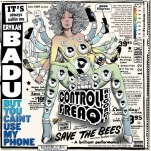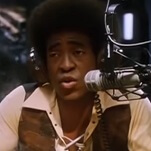I don’t watch trailers. I mean, I’ll watch them in a movie theater, obviously—I’m not gonna close my eyes and stick my fingers in my ears for up to 15 minutes, going la-la-la. But I don’t generally seek them out online, because I’d rather not be laboriously conducted through every single beat of a movie’s narrative in advance. Lately, however, in addition to the official trailer(s), more and more studios and distributors have been making brief clips from their films available, which is a welcome development, if not necessarily a smart move on their part. There’s no question that two or three contiguous minutes provides a much stronger indication of a movie’s appeal than does a jumble of disconnected images and one-liners—you can get a sense of its overall tone, and usually discern whether it’s interesting enough to hold your attention on a moment-to-moment basis. (If you get bored by a two-minute clip, that’s a very bad sign.)
This holds true no matter how noble anybody’s intentions are, it turns out. For example, animator Nina Paley, not some faceless marketing team, created the trailer for her wonderful Sita Sings The Blues, which at the time had no apparent shot at any kind of legitimate release, due to music-clearance issues. (Thankfully, those have since been resolved; it’s now out on DVD.) Had I seen only that trailer, however, I can’t say I would have been salivating particularly hard—it looks colorful and busy, to be sure, but the movie’s unique flavor doesn’t remotely come across. When Sita screened in New York in late 2008 as part of a Gotham Film Awards program, though, the Museum Of Modern Art didn’t show the trailer. Instead, it simply showed about a minute of the scene I’m about to show you. Might not even have been a full minute, actually. Perhaps only 30 seconds. It was enough. I barely made it inside at the following day’s screening; dozens were turned away. And I have yet to show this number to anybody whose appetite it failed to whet. If you’re the exception, I can only ask “What’s wrong with you?”
You don’t need to know that you’re hearing a 1927 recording by the largely forgotten jazz singer Annette Hanshaw, singing a tune co-written by the great Gus Kahn (“It Had To Be You,” “Makin’ Whoopee”). You don’t need to know that the characters in this scene were inspired by the ancient Sanskrit epic The Ramayana, or that Paley is using The Ramayana’s story as a parallel to her own failed marriage. You don’t need to know that Paley animated this entire scene—indeed, the entire 82-minute feature—entirely on her own, in Flash, working on her home computer for more than three years. All that stuff is interesting, but it doesn’t matter. All that matters is that you’re watching a skimpily dressed, ultra-curvaceous cartoon hottie warble a hopeful love song while a giant army of helmet-clad apes proceeds to brutally eviscerate an equally sizable army of one-eyed, mustachioed demons with man-boobs. What matters is that you know you’re in the hands of somebody with a crazily fertile imagination.
On a basic level, what Paley’s doing here isn’t especially radical. There’s a long tradition of movies that juxtapose cheery music with extreme violence: Malcolm McDowell performing an impromptu rendition of “Singin’ In The Rain” as he and his fellow droogs torture a helpless couple; Michael Madsen grooving with a straight razor to “Stuck In The Middle With You.” But this scene isn’t intended to horrify, the way those are—it’s a lark. The “victims” are grotesque, their deaths deliberately cartoonish (even within the context of a cartoon), with X’d-out eyes for the corpses. What makes it funny is Sita’s complete obliviousness to the gorefest happening all around her. She’s so focused on whether that’s her beloved at the door that she fails to notice the bodies piling up around her feet, or the giant wave of blood and hacked limbs rising just behind her. (In that sense, it’s closer in spirit to Simon Pegg’s jaunt to the corner market early in Shaun Of The Dead, when he’s too hungover to notice the zombies all around him.)
What’s more impressive still is how beautifully this scene works as a musical number—how expertly it’s choreographed. I’ve seen too little Flash work to pronounce judgment on the technical quality of Paley’s animation, but her sense of timing is exquisite. (Since her professional background was in comics, that was by no means a given.) The song’s second verse (“Me oh my, my oh me…”) in particular is a marvel, in terms of the interplay between the song’s tempo and the flying body parts, as well as the constant, perfectly judged shifts in direction, left/right and front/back. You get the smack-smack-smack of bloody viscera against the wall Sita’s looking over, then she turns around and there’s a corresponding series of chopping noises and flying demon bits, on exactly the same beat, but with four rather than three, so it doesn’t feel too robotic. Then there’s the blizzard of demon spears sailing overhead from left to right, and the return volley of arrows moving right to left, with the latter continuing in the background as Paley cuts from the wide shot to a medium close-up. And it continues in that dynamically syncopated vein throughout the second chorus. Remarkable.
Now, in fairness, the flip side of decontextualizing a scene like this and using it as an alternate trailer is that you have no way of knowing whether these three minutes feel fresh and robust in their proper place. While this is my favorite of the film’s musical numbers, and the obvious showstopper, I could probably have impressed you almost as much by showing you the final one (“I Got A Feeling I’m Fallin’), which would look marvelous if it were the only bit you’d seen. What you wouldn’t know, however, is that it’s the 11th Annette Hanshaw song in the movie. I love Sita Sings The Blues, and recommend it without hesitation to anyone who enjoyed this clip, but I must admit, even as a fan, that a slight weariness does set in by the time that last number rolls around, simply because you’ve already witnessed 10 similar extravaganzas. For all her extraordinary talent, Paley can’t wring that many diverting changes around this one singer’s repertoire. So this approach is potentially misleading in its own way. But I’d still much rather decide whether a film is for me based on watching any given few minutes of it unfold, rather than having marketing toss its idea of the highlights into a blender and hit purée. You can tell pretty quickly whether something is working for you.
That’s all!








































